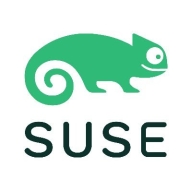

Find out in this report how the two Container Security solutions compare in terms of features, pricing, service and support, easy of deployment, and ROI.
| Product | Market Share (%) |
|---|---|
| Veracode | 3.4% |
| SUSE Rancher | 0.4% |
| Other | 96.2% |


| Company Size | Count |
|---|---|
| Small Business | 69 |
| Midsize Enterprise | 43 |
| Large Enterprise | 112 |
SUSE Rancher manages and deploys Kubernetes clusters, simplifies container orchestration, and enhances DevOps practices, supporting multi-cloud environments and facilitating application scalability and monitoring.
SUSE Rancher provides robust Kubernetes cluster management and seamless integration with different tools and platforms, making it valuable for complex cloud infrastructures. It aids in automating workflows, ensuring consistent application performance across environments, and enhancing security with reliable RBAC. It simplifies operations with automated updates and comprehensive monitoring tools, supporting multiple Kubernetes distributions. SUSE Rancher offers centralized management of clusters with an intuitive experience, though it may benefit from better stability, performance optimizations, and improved documentation clarity.
What are the important features?SUSE Rancher is implemented in various industries where managing Kubernetes clusters and ensuring application scalability are critical. It supports complex cloud infrastructures, automating workflows, and integrating seamlessly with different tools, enhancing overall operational efficiency and security. In industries needing consistent performance and centralized management, SUSE Rancher proves to be an invaluable tool.
Veracode is a leading provider of application security solutions, offering tools to identify, mitigate, and prevent vulnerabilities across the software development lifecycle. Its cloud-based platform integrates security into DevOps workflows, helping organizations ensure that their code remains secure and compliant with industry standards.
Veracode supports multiple application security testing types, including static analysis (SAST), dynamic analysis (DAST), software composition analysis (SCA), and manual penetration testing. These tools are designed to help developers detect vulnerabilities early in development while maintaining speed in deployment. Veracode also emphasizes scalability, offering features for enterprises that manage a large number of applications across different teams. Its robust reporting and analytics capabilities allow organizations to continuously monitor their security posture and track progress toward remediation.
What are the key features of Veracode?
What benefits should users consider in Veracode reviews?
Veracode is widely adopted in industries like finance, healthcare, and government, where compliance and security are critical. It helps these organizations maintain strict security standards while enabling rapid development through its integration with Agile and DevOps methodologies.
Veracode helps businesses secure their applications efficiently, ensuring they can deliver safe and compliant software at scale.
We monitor all Container Security reviews to prevent fraudulent reviews and keep review quality high. We do not post reviews by company employees or direct competitors. We validate each review for authenticity via cross-reference with LinkedIn, and personal follow-up with the reviewer when necessary.